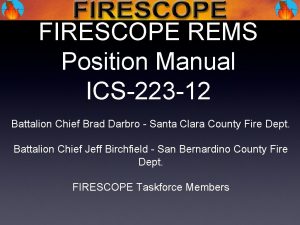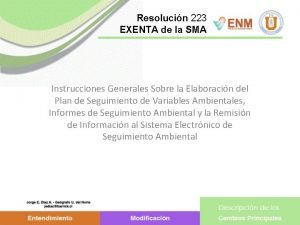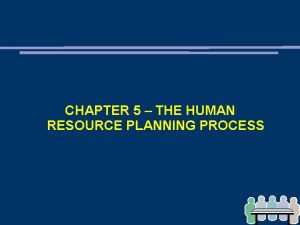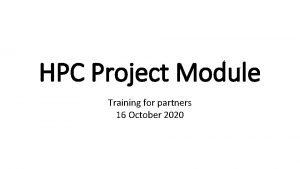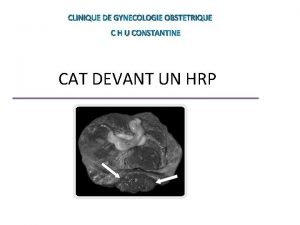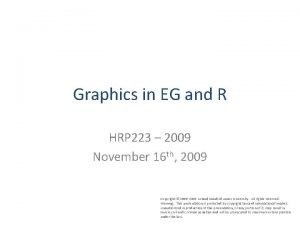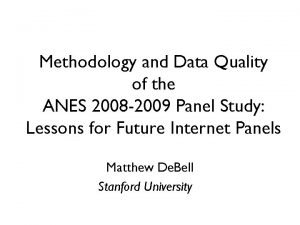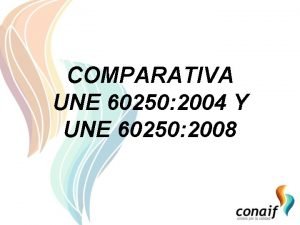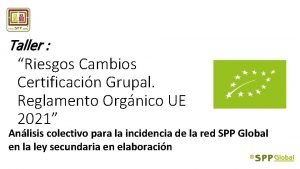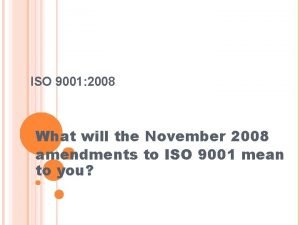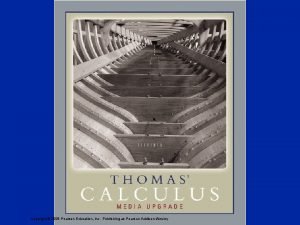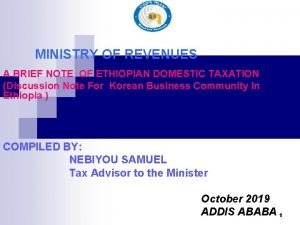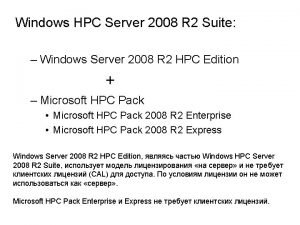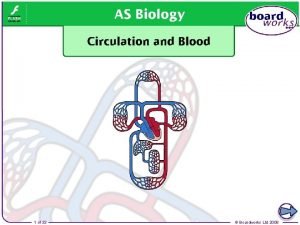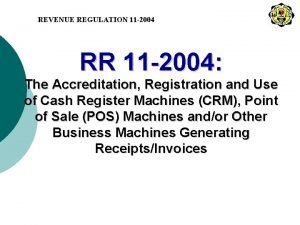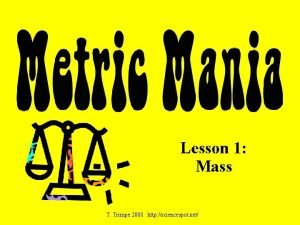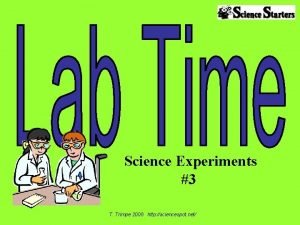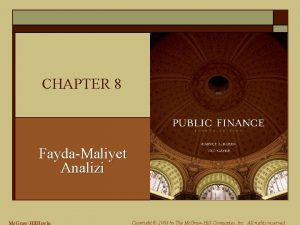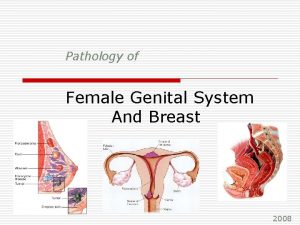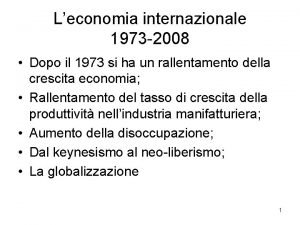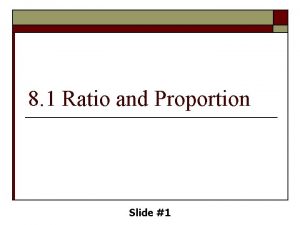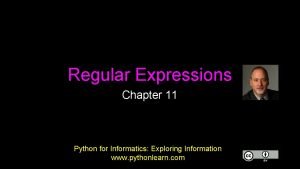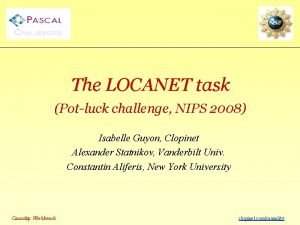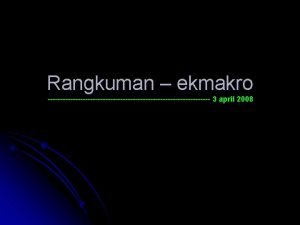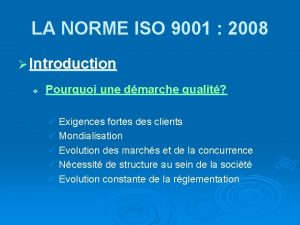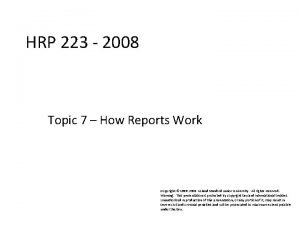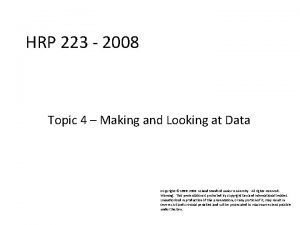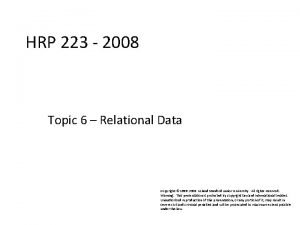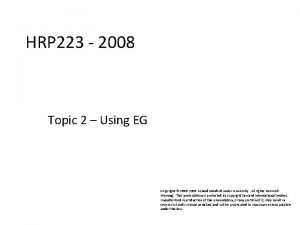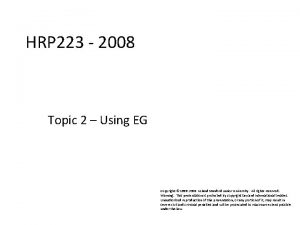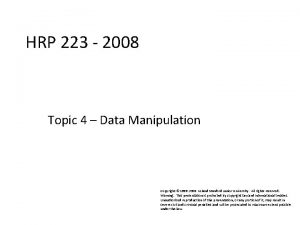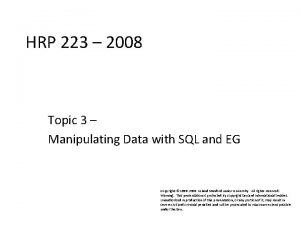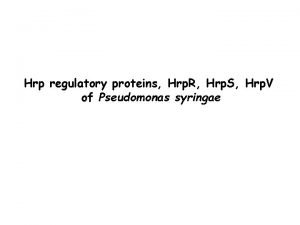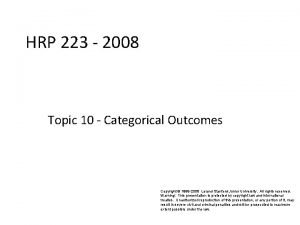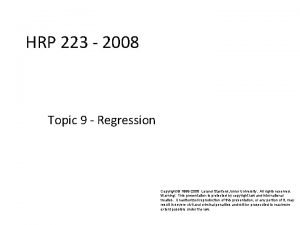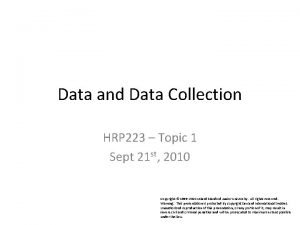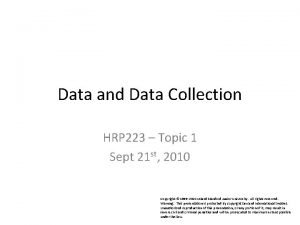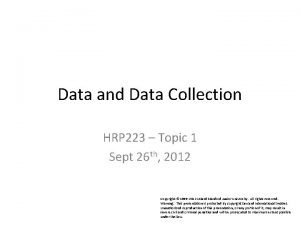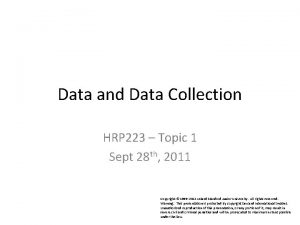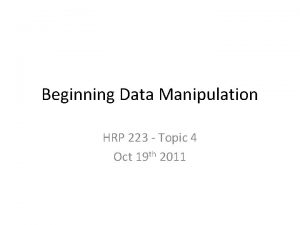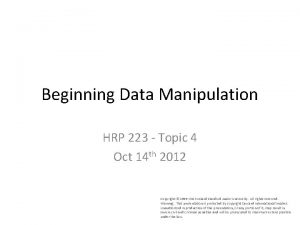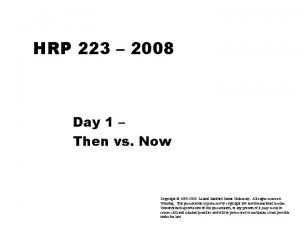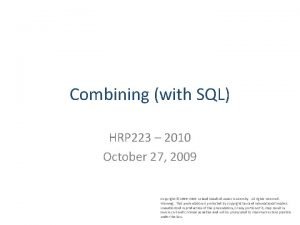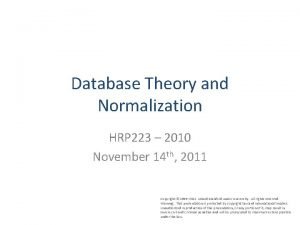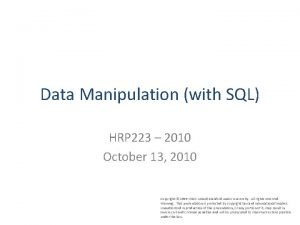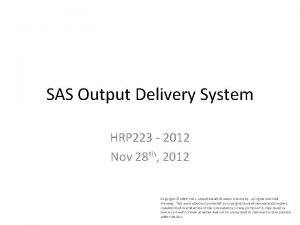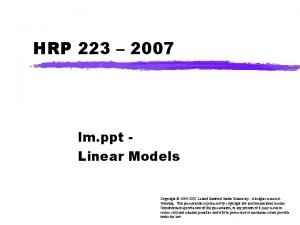HRP 223 2008 HRP 223 2008 Topic 8


























































- Slides: 58

HRP 223 - 2008 HRP 223 2008 Topic 8 – Analysis of Means Copyright © 1999 -2008 Leland Stanford Junior University. All rights reserved. Warning: This presentation is protected by copyright law and international treaties. Unauthorized reproduction of this presentation, or any portion of it, may result in severe civil and criminal penalties and will be prosecuted to maximum extent possible under the law.

One Categorical Predictor HRP 223 2008 Normally Distributed Not Normally Distributed One sample vs. population One sample t-test Wilcoxon Signed Rank Two paired samples Paired t-test Difference then Signed Rank Two unpaired samples T-test Wilcoxon Rank-sum Three or more unpaired samples ANOVA Kruskal-Wallis Three or more paired samples Mixed effects Transform then mixed model Normally Distributed Not Normally Distributed One sample vs. population Describe > Distribution Two paired samples Analyze >ANOVA>t-test Describe > Distribution Two unpaired samples Analyze >ANOVA>t-test Describe > Distribution Three or more unpaired samples Analyze >ANOVA>Linear Analyze >ANOVA>Nonpar. Three or more paired samples Analyze >ANOVA>Mixed

Multiple Categorical Predictors § Unpaired samples HRP 223 2008 – ANOVA § Paired samples – Mixed Effects Models § If data is not normally distributed – There are spcialized statistics (Friedman’s test for 2 predictors). – Try to transform into normally distributed.

Mean vs. Expected BMI It would be nice to see the actual Excel file.

Adds a link to source and runs import wizard This gives instant access to the current state of the spreadsheet but it is bugged if you mix character and numeric data.

Take a Look at the Data HRP 223 2008

Prior to analysis, do all 3 plots. Histograms and box plots show outliers and bimodal data but are not ideal for assessing normality. The formal tests for normality are not great. They will not find problems with small samples and will declare problems with large samples.


. 3. . . . . . . . . 5. . 4. . . . . 1. normal distribution. . . 2. skewed-to-the-right distribution. . . . . 3. skewed-to-the-left distribution. . 4. heavy-tailed distribution. . . . 5. light-tailed distribution 1. 2. Image from: Statistics I: Introduction to ANOVA, Regression, and Logistic Regression: Course Notes. SAS Press 2008.

Inference 101 HRP 223 2008 § You only have one sample but you want to make inferences to the world. § Given what you see in this sample, you can guess what the distribution of samples looks like around the null distribution.

If the population you are sampling from has a mean of 4, you will not observe a score of 4. Make a histogram of the means How do you compare this sample vs. another with a mean of 5?

Distributions of the Means . 75/sqrt(1) =. 75/sqrt(5) =. 34 . 75/sqrt(25) =. 15

Precision HRP 223 2008 § Think of the “+/- something” imprecision in the estimates of the political polls. § You typically end up saying you are 95% sure you chose an interval that has the true value inside the range bracketed by the confidence limits (CLs). Either the population value is or is not in the interval between the lower and upper confidence limit, and if you repeated the process on many samples, 95% of such intervals would include the population value. § The 99% CI is wider (more accurate) than the more precise 95% CL.

Confidence Intervals from 10 Samples The unobservable truth You want to set the width of the interval so that in 95% of the experiments, the confidence interval includes the true value. In theory, you tweak the interval and increase or decrease the width. Axis with units showing your outcome

Benefits of CLs HRP 223 2008 § You have information about the estimate's precision. § The width of the CI tells you about the degree of random error which is set by the confidence interval. § Wide intervals indicate poor precision. Plausible values could be across a broad range.

Estimation vs. Hypothesis Testing HRP 223 2008 § P-value <. 05 corresponds to a 95% CL that does not include the null hypothesis value. § CLs show uncertainty, or lack of precision, in the estimate of interest and thus convey more useful information than the p-value.

0 difference between groups or odds ratio of 1 CLs vs. p-values null value Lower CL Upper CL P >. 05 and the null value is inside of the confidence limits (CLs) Confidence interval null value Lower CL P <. 05 and the null value is not inside of the confidence limits Upper CL Confidence interval

null value zone of clinical indifference Not statistically significant and not clinically interesting Not statistically significant, possibly clinically interesting Statistically significant but not clinically interesting Statistically significant and clinically interesting


Compare Two Teachers § Import the data § Describe the data HRP 223 2008 – Assign the method as a classification variable § Do an unpaired T-test § Do a one-way ANOVA with the predictor having only two levels





SS total is the sum of the distance between each point and the overall mean line squared. SS error is the sum of the total squared distances between each point and the group mean lines.

HRP 223 2008



Psoriasis § Scores are arbitrary numbers 0 = < 0% response, 5 = 26 -50% response, etc.



If and only if you work on a fast machine! HRP 223 2008

Weight Gain HRP 223 2008









Postpartum Depression

After the Formats






Dementia





Wide to Long HRP 223 2008 § You may have noticed that the data for these analyses are all set up as long, skinny files where there is a record for every observation on a patient. Some people store data as wide records with many variables with a single record for each person. § To convert from wide to long: – Do data step processing with arrays. – Use the Transpose option on the Data menu. – Combine proc transpose and data step code. – Use a macro I wrote. (It is brand new, so check it. )

Tolerance. sas 7 bdat is dataset from the book Save a copy of the macro in a file after the fill in the blanks are done.

The stuff in the macro file: The stuff in the blah. sas file:

tol: all variables starting with the letters tol

Narrow to Wide HRP 223 2008 § Of course you can transpose back to wide from narrow. § If you download the keyboard macros today you will see that proc transpose now gives you a code template.
 Ics 223-12
Ics 223-12 Dl 11cd
Dl 11cd Res 223 sma
Res 223 sma Hqda exords
Hqda exords 2008 2008
2008 2008 How to write a clincher sentence
How to write a clincher sentence Broad topic and specific topic examples
Broad topic and specific topic examples Hrp cream
Hrp cream Forecasting techniques in human resource planning
Forecasting techniques in human resource planning Western blot detection 원리
Western blot detection 원리 Nature of hrp
Nature of hrp Hrp ecl 원리
Hrp ecl 원리 Requisites for successful hrp
Requisites for successful hrp Skyward jordan employee
Skyward jordan employee Hrp project module
Hrp project module Human resources planning definition
Human resources planning definition Greg nickless hcd
Greg nickless hcd Hr
Hr Classification de sher hrp
Classification de sher hrp Project based hrp consists of
Project based hrp consists of Hr planning meaning
Hr planning meaning Hrp graphics
Hrp graphics Anes 2008
Anes 2008 Norma une 60250
Norma une 60250 889 2008
889 2008 Iso 9001:2008 certification in mumbai
Iso 9001:2008 certification in mumbai Pearson education
Pearson education Stamp duty(amendment) proclamation no. 612/2008
Stamp duty(amendment) proclamation no. 612/2008 Windows hpc server
Windows hpc server 2008
2008 Copyright 2008
Copyright 2008 27 juni 2008
27 juni 2008 Google code jam 2008
Google code jam 2008 Classification of algae
Classification of algae Dessler 2008
Dessler 2008 Sworn statement for esales registration
Sworn statement for esales registration Ssis 2008 training
Ssis 2008 training 2008
2008 Www middleschoolscience com 2008
Www middleschoolscience com 2008 Vaz, 2008, p. 63
Vaz, 2008, p. 63 T. trimpe 2008 http://sciencespot.net/
T. trimpe 2008 http://sciencespot.net/ Implasyon tula
Implasyon tula Controlled variable science
Controlled variable science Ipam server 2008
Ipam server 2008 Copyright 2008
Copyright 2008 2008
2008 2008-1973
2008-1973 June 20 2008
June 20 2008 Framework decision 2008/913/jha
Framework decision 2008/913/jha From [email protected] sat jan 5 09:14:16 2008
From [email protected] sat jan 5 09:14:16 2008 Pearson education inc publishing as pearson prentice hall
Pearson education inc publishing as pearson prentice hall Nips 2008
Nips 2008 The hurt locker 2008
The hurt locker 2008 Pearson education limited 2008
Pearson education limited 2008 3 april 2008
3 april 2008 Kielhofner 2008
Kielhofner 2008 Norme iso 9001 2008
Norme iso 9001 2008 2008
2008 Giw/isso 2008
Giw/isso 2008
